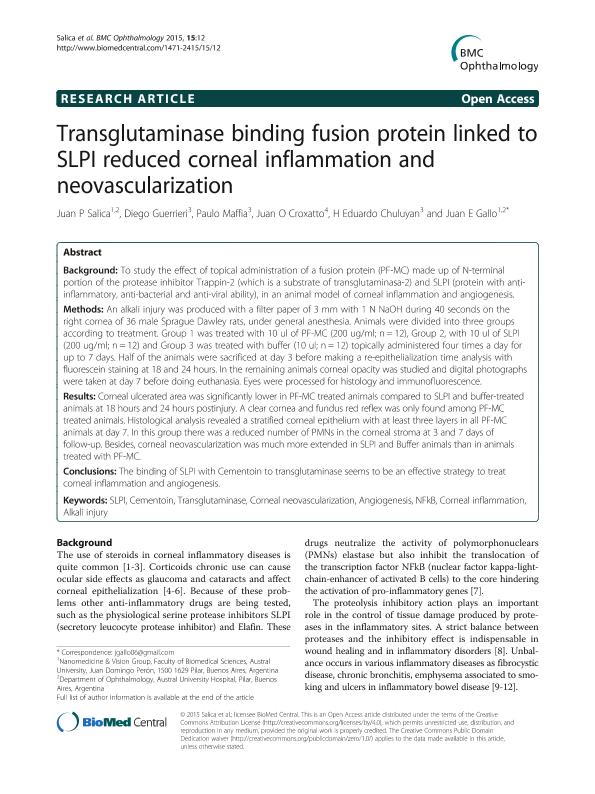Mostrar el registro sencillo del ítem
dc.contributor.author
Salica, Juan Pablo

dc.contributor.author
Guerrieri, Diego

dc.contributor.author
Maffia, Paulo Cesar

dc.contributor.author
Croxatto, Juan Oscar

dc.contributor.author
Chuluyan, Hector Eduardo

dc.contributor.author
Gallo, Juan Eduardo Maria

dc.date.available
2017-03-17T19:41:24Z
dc.date.issued
2015-02
dc.identifier.citation
Salica, Juan Pablo; Guerrieri, Diego; Maffia, Paulo Cesar; Croxatto, Juan Oscar; Chuluyan, Hector Eduardo; et al.; Transglutaminase binding fusion protein linked to SLPI reduced corneal inflammation and neovascularization; BioMed Central; BMC Ophthalmology; 15; 12; 2-2015; 12-21
dc.identifier.issn
1471-2415
dc.identifier.uri
http://hdl.handle.net/11336/14054
dc.description.abstract
Background: To study the effect of topical administration of a fusion protein (PF-MC) made up of N-terminal portion of the protease inhibitor Trappin-2 (which is a substrate of transglutaminasa-2) and SLPI (protein with anti-inflammatory, anti-bacterial and anti-viral ability), in an animal model of corneal inflammation and angiogenesis. Methods: An alkali injury was produced with a filter paper of 3 mm with 1 N NaOH during 40 seconds on the right cornea of 36 male Sprague Dawley rats, under general anesthesia. Animals were divided into three groups according to treatment. Group 1 was treated with 10 ul of PF-MC (200 ug/ml; n = 12), Group 2, with 10 ul of SLPI (200 ug/ml; n = 12) and Group 3 was treated with buffer (10 ul; n = 12) topically administered four times a day for up to 7 days. Half of the animals were sacrificed at day 3 before making a re-epithelialization time analysis with fluorescein staining at 18 and 24 hours. In the remaining animals corneal opacity was studied and digital photographs were taken at day 7 before doing euthanasia. Eyes were processed for histology and immunofluorescence. Results: Corneal ulcerated area was significantly lower in PF-MC treated animals compared to SLPI and buffer-treated animals at 18 hours and 24 hours postinjury. A clear cornea and fundus red reflex was only found among PF-MC treated animals. Histological analysis revealed a stratified corneal epithelium with at least three layers in all PF-MC animals at day 7. In this group there was a reduced number of PMNs in the corneal stroma at 3 and 7 days of follow-up. Besides, corneal neovascularization was much more extended in SLPI and Buffer animals than in animals treated with PF-MC. Conclusions: The binding of SLPI with Cementoin to transglutaminase seems to be an effective strategy to treat corneal inflammation and angiogenesis.
dc.format
application/pdf
dc.language.iso
eng
dc.publisher
BioMed Central

dc.rights
info:eu-repo/semantics/openAccess
dc.rights.uri
https://creativecommons.org/licenses/by/2.5/ar/
dc.subject
Slpi
dc.subject
Cementoin
dc.subject
Transglutaminase
dc.subject
Corneal Neovascularization
dc.subject
Angiogenesis
dc.subject
Nfkb
dc.subject
Corneal Inflammation
dc.subject
Alkali Injury
dc.subject.classification
Farmacología y Farmacia

dc.subject.classification
Medicina Básica

dc.subject.classification
CIENCIAS MÉDICAS Y DE LA SALUD

dc.title
Transglutaminase binding fusion protein linked to SLPI reduced corneal inflammation and neovascularization
dc.type
info:eu-repo/semantics/article
dc.type
info:ar-repo/semantics/artículo
dc.type
info:eu-repo/semantics/publishedVersion
dc.date.updated
2017-03-09T15:06:48Z
dc.journal.volume
15
dc.journal.number
12
dc.journal.pagination
12-21
dc.journal.pais
Reino Unido

dc.journal.ciudad
Londres
dc.description.fil
Fil: Salica, Juan Pablo. Universidad Austral. Facultad de Ciencias Biomedicas; Argentina. Hospital Universitario Austral. Departamento de Oftalmología; Argentina. Consejo Nacional de Investigaciones Científicas y Técnicas; Argentina
dc.description.fil
Fil: Guerrieri, Diego. Consejo Nacional de Investigaciones Científicas y Técnicas. Oficina de Coordinación Administrativa Houssay. Centro de Estudios Farmacológicos y Botánicos; Argentina. Universidad de Buenos Aires. Facultad de Medicina; Argentina
dc.description.fil
Fil: Maffia, Paulo Cesar. Consejo Nacional de Investigaciones Científicas y Técnicas. Oficina de Coordinación Administrativa Houssay. Centro de Estudios Farmacológicos y Botánicos; Argentina. Universidad de Buenos Aires. Facultad de Medicina; Argentina
dc.description.fil
Fil: Croxatto, Juan Oscar. Consejo Nacional de Investigaciones Científicas y Técnicas; Argentina. Fundación Oftalmología Argentina "J. Malbrán"; Argentina
dc.description.fil
Fil: Chuluyan, Hector Eduardo. Consejo Nacional de Investigaciones Científicas y Técnicas. Oficina de Coordinación Administrativa Houssay. Centro de Estudios Farmacológicos y Botánicos; Argentina. Universidad de Buenos Aires. Facultad de Medicina; Argentina
dc.description.fil
Fil: Gallo, Juan Eduardo Maria. Universidad Austral. Facultad de Ciencias Biomedicas; Argentina. Consejo Nacional de Investigaciones Científicas y Técnicas; Argentina. Hospital Universitario Austral. Departamento de Oftalmología; Argentina
dc.journal.title
BMC Ophthalmology
dc.relation.alternativeid
info:eu-repo/semantics/altIdentifier/url/http://bmcophthalmol.biomedcentral.com/articles/10.1186/1471-2415-15-12
dc.relation.alternativeid
info:eu-repo/semantics/altIdentifier/doi/http://dx.doi.org/10.1186/1471-2415-15-12
Archivos asociados
